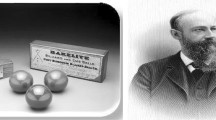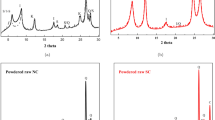Abstract
A new thermoset PLA resin was synthesized. The structure and performance of the thermoset PLA resin were characterized by Fourier transform infrared spectroscopy (FTIR), 1H Nuclear Magnetic Resonance (1H-NMR), 13C Nuclear Magnetic Resonance (13C-NMR), differential scanning calorimetry (DSC) and thermogravimetric analysis (TGA) testing methods. The results indicate that thermoset PLA resin has been synthesized successfully, and the thermal stability of thermoset PLA is better than that of linear PLA. Thermoset PLA resin and ramie/thermoset poly(lactic acid) (PLA) composites were prepared by casting and hot-pressing, respectively. The degradation behavior was evaluated by surface morphology observation, scanning electron microscope (SEM), pH detection and FTIR analysis. The results show that the thermoset PLA resin fully degrades after 20 days, and the degradation rate of ramie/thermoset PLA composites is only 45.27% after 30 days, which is lower than that of thermoset PLA. The reason is due to that ramie fabric as the barrier hinders the moisture and microorganisms enter the interior of the composites. Moreover, according to the FTIR analysis, the ester groups of thermoset PLA are firstly hydrolyzed, and thermoset PLA is decomposed into low molecular weight oligomers. Then thermoset PLA and oligomers are continuously hydrolyzed by moisture and microorganisms until mineralized into H2O and CO2. Besides, the soil pH value detection proves that no acidic or alkaline harmful degradation products are produced during the soil degradation process.
















Similar content being viewed by others
References
Li Y, Li Q, Ma H (2015) The voids formation mechanisms and their effects on the mechanical properties of flax fiber reinforced epoxy composites. Compos Part a-Appl S 72:40–48. https://doi.org/10.1016/j.compositesa.2015.01.029
Torres FG, Rodriguez S, Saavedra AC (2019) Green composite materials from biopolymers reinforced with agroforestry waste. J Polym Environ 27(12):2651–2673. https://doi.org/10.1007/s10924-019-01561-5
Shih YF, Kotharangannagari VK, Tsou TC (2020) Development of eco-friendly modified cellulose nanofiber reinforced polystyrene nanocomposites: thermal, mechanical, and optical properties. J Polym Res 27(7). https://doi.org/10.1007/s10965-020-02156-8
Yu T, Li Y (2014) Influence of poly(butylenes adipate-co-terephthalate) on the properties of the biodegradable composites based on ramie/poly(lactic acid). Compos Part a-Appl S 58:24–29. https://doi.org/10.1016/j.compositesa.2013.11.013
Kaseem M, Hamad K, Deri F, Ko YG (2017) A review on recent researches on polylactic acid/carbon nanotube composites. Polym Bull 74(7):2921–2937. https://doi.org/10.1007/s00289-016-1861-6
Gurunathan T, Mohanty S, Nayak SK (2015) A review of the recent developments in biocomposites based on natural fibres and their application perspectives. Compos Part a-Appl S 77:1–25. https://doi.org/10.1016/j.compositesa.2015.06.007
Cinelli P, Chiellini E, Lawton JW, Imam SH (2006) Properties of injection molded composites containing corn fiber and poly(vinyl alcohol). J Polym Res 13(2):107–113. https://doi.org/10.1007/s10965-005-9012-z
Saleem A, Medina L, Skrifvars M (2020) Mechanical performance of hybrid bast and basalt fibers reinforced polymer composites. J Polym Res 27(3). https://doi.org/10.1007/s10965-020-2028-6
Tavassoli F, Razzaghi-Kashani M, Mohebby B (2017) Hydrothermally treated wood as reinforcing filler for natural rubber bio-composites. J Polym Res 25(1). https://doi.org/10.1007/s10965-017-1394-1
Tsou CH, Yao WH, Wu CS, Tsou CY, Hung WS, Chen JC, Guo JP, Yuan S, Wen E, Wang RY, Sunn MC, Liu SC, De Guzman MR (2019) Preparation and characterization of renewable composites from Polylactide and Rice husk for 3D printing applications. J Polym Res 26(9). https://doi.org/10.1007/s10965-019-1882-6
Garlotta D (2001) A literature review of poly(lactic acid). J Polym Environ 9(2):63–84. https://doi.org/10.1023/A:1020200822435
Jadhav H, Jadhav A, Takkalkar P, Hossain N, Nizammudin S, Zahoor M, Jamal M, Mubarak NM, Griffin G, Kao N (2020) Potential of polylactide based nanocomposites-nanopolysaccharide filler for reinforcement purpose: a comprehensive review. J Polym Res 27(11). https://doi.org/10.1007/s10965-020-02287-y
Chang SK, Zeng C, Li JB, Ren J (2012) Synthesis of polylactide-based thermoset resin and its curing kinetics. Polym Int 61(10):1492–1502. https://doi.org/10.1002/pi.4233
Chen CK, Huang PK, Law WC, Chu CH, Chen NT, Lo LW (2020) Biodegradable polymers for gene-delivery applications. Int J Nanomed 15:2131–2150. https://doi.org/10.2147/Ijn.S222419
Stewart SA, Dominguez-Robles J, McIlorum VJ, Gonzalez Z, Utomo E, Mancuso E, Lamprou DA, Donnelly RF, Larraneta E (2020) Poly(caprolactone)-Based Coatings on 3D-Printed Biodegradable Implants: A Novel Strategy to Prolong Delivery of Hydrophilic Drugs. Mol Pharmaceut 17(9):3487–3500. https://doi.org/10.1021/acs.molpharmaceut.0c00515
Zou J, Yu Y, Yu L, Li YK, Chen CK, Cheng C (2012) Well-defined drug-conjugated biodegradable nanoparticles by azide-alkyne click crosslinking in miniemulsion. J Polym Sci Pol Chem 50(1):142–148. https://doi.org/10.1002/pola.25016
Yu T, Hu CQ, Chen XJ, Li Y (2015) Effect of diisocyanates as compatibilizer on the properties of ramie/poly(lactic acid) (PLA) composites. Compos Part a-Appl S 76:20–27. https://doi.org/10.1016/j.compositesa.2015.05.010
Jiang N, Yu T, Li Y, Pirzada TJ, Marrow TJ (2019) Hygrothermal aging and structural damage of a jute/poly (lactic acid) (PLA) composite observed by X-ray tomography. Compos Sci Technol 173:15–23. https://doi.org/10.1016/j.compscitech.2019.01.018
Chesnokov SA, Aleynik DY, Kovylin RS, Yudin VV, Egiazaryan TA, Egorikhina MN, Zaslavskaya MI, Rubtsova YP, Gusev SA, Mlyavykh SG, Fedushkin IL (2021) Porous polymer scaffolds based on cross-linked Poly-EGDMA and PLA: Manufacture, antibioticsr encapsulation, and in vitro study. Macromol Biosci 21(5). https://doi.org/10.1002/mabi.202000402
Chen CK, Lin WJ, Hsia Y, Lo LW (2017) Synthesis of Polylactide-Based Core-Shell Interface Cross-Linked Micelles for Anticancer Drug Delivery. Macromol Biosci 17(3). https://doi.org/10.1002/mabi.201600191
Huang HQ, Guo XS, Gu JY, Zhang YZ, Chen Q, Wei ZZ (2020) Biodegradable poly(lactic acid)/poly(butylene succinate) Nanofibrous membrane with Core-shell structure and high density for improved mechanical properties. J Polym Res 27(9). https://doi.org/10.1007/s10965-020-02265-4
Song YA, Liu J, Chen SZ, Zheng YB, Ruan SL, Bin YZ (2013) Mechanical properties of poly (lactic acid)/hemp fiber composites prepared with a novel method. J Polym Environ 21(4):1117–1127. https://doi.org/10.1007/s10924-013-0569-z
Ketabchi MR, Ratnam CT, Khalid M, Walvekar R (2018) Mechanical properties of polylactic acid/synthetic rubber blend reinforced with cellulose nanoparticles isolated from kenaf fibres. Polym Bull 75(2):809–827. https://doi.org/10.1007/s00289-017-2061-8
Shih YF, Huang CC (2011) Polylactic acid (PLA)/banana fiber (BF) biodegradable green composites. J Polym Res 18(6):2335–2340. https://doi.org/10.1007/s10965-011-9646-y
Michalski A, Brzezinski M, Lapienis G, Biela T (2019) Star-shaped and branched polylactides: Synthesis, characterization, and properties. Prog Polym Sci 89:159–212. https://doi.org/10.1016/j.progpolymsci.2018.10.004
Choinska E, Muroya T, Swieszkowski W, Aoyagi T (2016) Influence of macromolecular structure of novel 2-and 4-armed polylactides on their physicochemical properties and in vitro degradation process. J Polym Res 23(7). https://doi.org/10.1007/s10965-016-1023-4
Jahandideh A, Muthukumarappan K (2017) Star-shaped lactic acid based systems and their thermosetting resins; synthesis, characterization, potential opportunities and drawbacks. Eur Polym J 87:360–379. https://doi.org/10.1016/j.eurpolymj.2016.12.035
Akesson D, Skrifvars M, Seppala J, Turunen M, Martinelli A, Matic A (2010) Synthesis and characterization of a lactic acid-based thermoset resin suitable for structural composites and coatings. J Appl Polym Sci 115(1):480–486. https://doi.org/10.1002/app.30800
Bakare FO, Skrifvars M, Akesson D, Wang YF, Afshar SJ, Esmaeili N (2014) Synthesis and characterization of bio-based thermosetting resins from lactic acid and glycerol. J Appl Polym Sci 131(13). https://doi.org/10.1002/app.40488
Ma H, Li Y, Shen YO, Xie L, Wang D (2016) Effect of linear density and yarn structure on the mechanical properties of ramie fiber yarn reinforced composites. Compos Part a-Appl S 87:98–108. https://doi.org/10.1016/j.compositesa.2016.04.012
Xie L, Xu H, Wang ZP, Li XJ, Chen JB, Zhang ZJ, Yin HM, Zhong GJ, Lei J, Li ZM (2014) Toward faster degradation for natural fiber reinforced poly(lactic acid) biocomposites by enhancing the hydrolysis-induced surface erosion. J Polym Res 21(3). https://doi.org/10.1007/s10965-014-0357-z
Vaisanen T, Batello P, Lappalainen R, Tomppo L (2018) Modification of hemp fibers (Cannabis Sativa L.) for composite applications. Ind Crop Prod 111:422–429. https://doi.org/10.1016/j.indcrop.2017.10.049
Chen X, Ren J, Zhang NW, Gu SY, Li JB (2015) Effects of heat treatment on the thermal and mechanical properties of ramie fabric-reinforced poly(lactic acid) biocomposites. J Reinf Plast Comp 34(1):28–36. https://doi.org/10.1177/0731684414562222
Sable S, Mandal DK, Ahuja S, Bhunia H (2019) Biodegradation kinetic modeling of oxo-biodegradable polypropylene/polylactide/nanoclay blends and composites under controlled composting conditions. J Environ Manage 249. https://doi.org/10.1016/j.jenvman.2019.06.087
Olewnik-Kruszkowska E, Burkowska-But A, Tarach I, Walczak M, Jakubowska E (2020) Biodegradation of polylactide-based composites with an addition of a compatibilizing agent in different environments. Int Biodeter Biodegr 147. https://doi.org/10.1016/j.ibiod.2019.104840
Siakeng R, Jawaid M, Asim M, Siengchin S (2020) Accelerated weathering and zoil burial effect on biodegradability, colour and texture of coir/pineapple leaf fibres/PLA biocomposites. Polymers-Basel 12(2). https://doi.org/10.3390/polym12020458
Weng YX, Wang L, Zhang M, Wang XL, Wang YZ (2013) Biodegradation behavior of P(3HB,4HB)/PLA blends in real soil environments. Polym Test 32(1):60–70. https://doi.org/10.1016/j.polymertesting.2012.09.014
Sun C, Huang ZX, Liu YF, Li CX, Tan HY, Zhang YH (2020) The effect of carbodiimide on the stability of wood fiber/poly(lactic acid) composites during soil degradation. J Polym Environ 28(4):1315–1325. https://doi.org/10.1007/s10924-020-01688-w
Rudnik E, Briassoulis D (2011) Comparative biodegradation in soil behaviour of two biodegradable polymers based on renewable resources. J Polym Environ 19(1):18–39. https://doi.org/10.1007/s10924-010-0243-7
Nampoothiri KM, Nair NR, John RP (2010) An overview of the recent developments in polylactide (PLA) research. Bioresource Technol 101(22):8493–8501
Tripathy S, Jali P, Parida C, Pradhan C (2020) Study on biodegradability and thermal behaviour of composites using poly lactic acid and gamma-irradiated fibres of Luffa cylindrica. Chemosphere 261. https://doi.org/10.1016/j.chemosphere.2020.127684
Pradhan R, Misra M, Erickson L, Mohanty A (2010) Compostability and biodegradation study of PLA-wheat straw and PLA-soy straw based green composites in simulated composting bioreactor. Bioresource Technol 101(21):8489–8491. https://doi.org/10.1016/j.biortech.2010.06.053
Hegyesi N, Zhang YC, Kohari A, Polyak P, Sui XF, Pukanszky B (2019) Enzymatic degradation of PLA/cellulose nanocrystal composites. Ind Crop Prod 141. https://doi.org/10.1016/j.indcrop.2019.111799
Surip SN, Jaafar WNRW (2018) Comparison study of the bio-degradation property of polylactic acid (Pla) Green Composites Reinforced by Kenaf Fibers. Int J Technol 9(6):1205–1215. https://doi.org/10.14716/ijtech.v9i6.2357
Lunt J (1998) Large-scale production, properties and commercial applications of polylactic acid polymers. Polym Degrad Stabil 59(1–3):145–152. https://doi.org/10.1016/S0141-3910(97)00148-1
Itavaara M, Karjomaa S, Selin JF (2002) Biodegradation of polylactide in aerobic and anaerobic thermophilic conditions. Chemosphere 46(6):879–885. https://doi.org/10.1016/S0045-6535(01)00163-1
Tokiwa Y, Suzuki T (1978) Hydrolysis of polyesters by Rhizopus-delemar lipase. Agr Biol Chem Tokyo 42(5):1071–1072. https://doi.org/10.1080/00021369.1978.10863111
Castro-Aguirre E, Auras R, Selke S, Rubino M, Marsh T (2018) Enhancing the biodegradation rate of poly(lactic acid) films and PLA bio-nanocomposites in simulated composting through bioaugmentation. Polym Degrad Stabil 154:46–54. https://doi.org/10.1016/j.polymdegradstab.2018.05.017
Acknowledgements
This work is supported by Natural Science Foundation of China (No. 11872279, No. 12172258 and No. 11625210), Natural Science Foundation of Shanghai (No. 18ZR1440700), the Fund of State Key Laboratory of Molecular Engineering of Polymers (Fudan University) and the Fundamental Research Funds for the Central Universities.
Author information
Authors and Affiliations
Corresponding authors
Additional information
Publisher's Note
Springer Nature remains neutral with regard to jurisdictional claims in published maps and institutional affiliations.
Rights and permissions
About this article
Cite this article
He, J., Yu, T., Chen, S. et al. Soil degradation behavior of ramie/thermoset poly(lactic acid) composites. J Polym Res 28, 379 (2021). https://doi.org/10.1007/s10965-021-02715-7
Received:
Accepted:
Published:
DOI: https://doi.org/10.1007/s10965-021-02715-7




